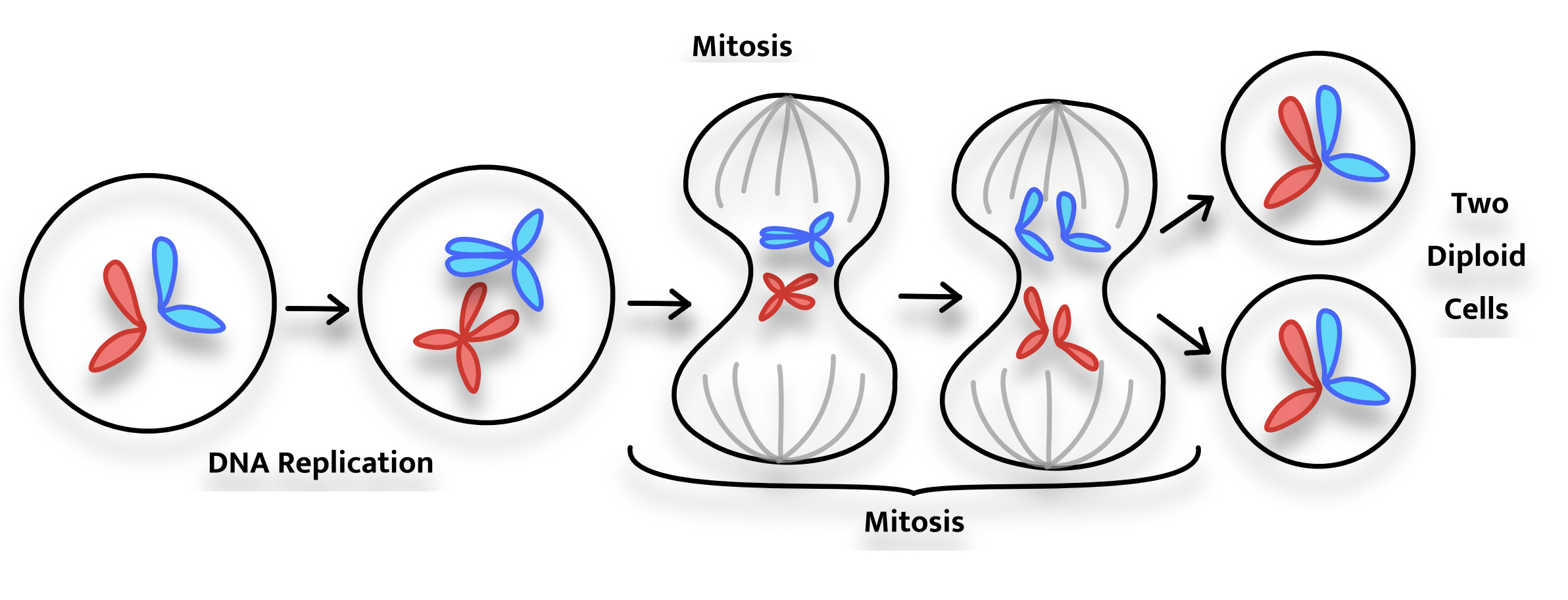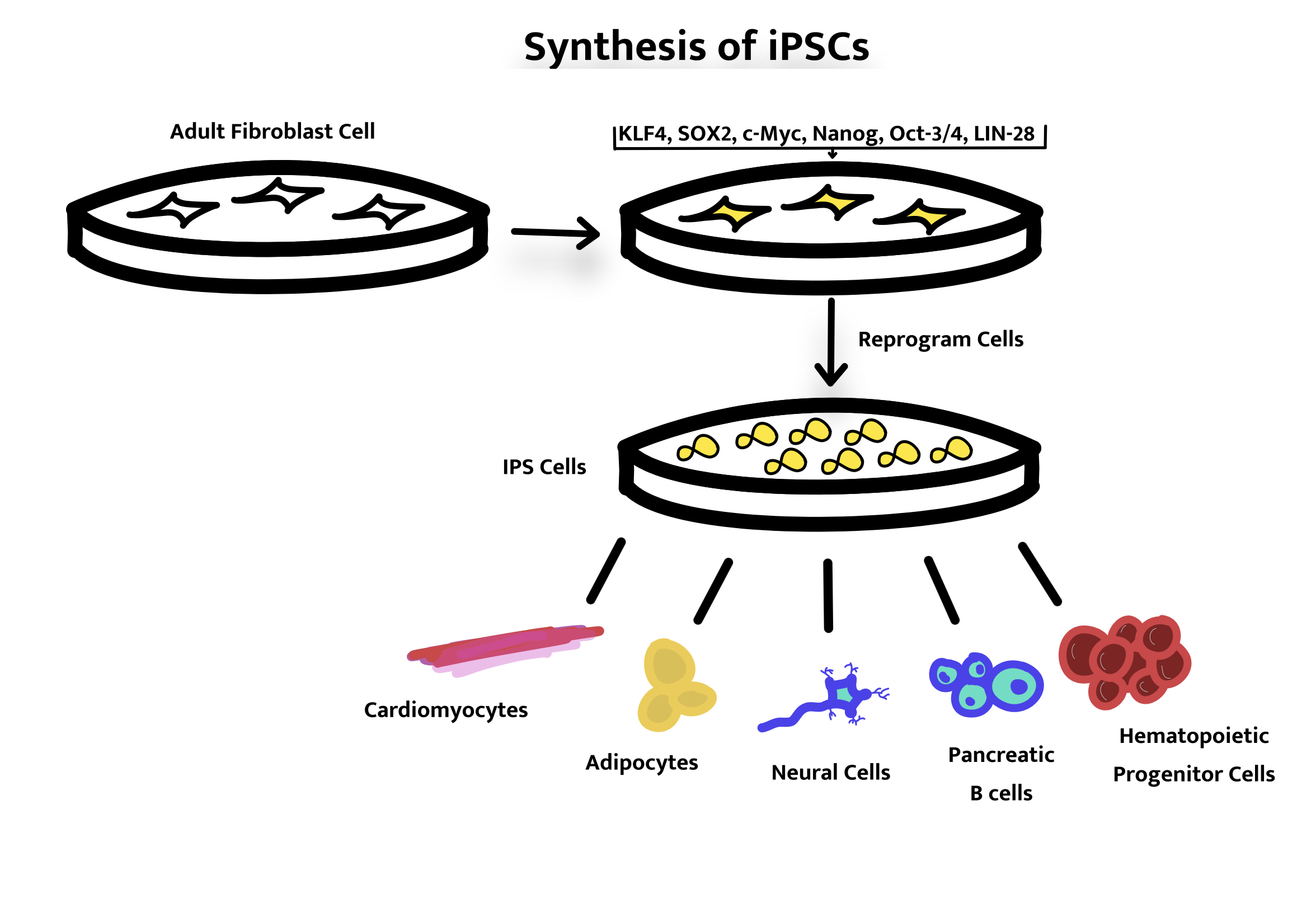Stem Cells
The three major characteristics which distinguish stem cells from other cell types are their ability to self-renew and proliferate via cell division, the fact that they are unspecialised, and their capacity to be induced into any cell type under specific physiologic or experimental conditions.
Stem cells can be described as the body’s rawest form of cells from which specialised functions can be generated to serve a purpose within a range of functions in the body. These cells can divide into two genetically identical daughter cells via the process of mitosis, allowing them to synthesise specialised cells and replace the loss of damaged cells.

Embryonic stem cells (ESCs) are found within the cell mass of a human fertilised egg between five or six days old, this rapidly diving ball of around 150 cells is named a blastocyst. These can divide into daughter cells if provided the right conditions, whether in the body or a laboratory. These daughter cells are pluripotent, meaning they can develop into new stem cells or specialised cells with a specific function such as blood, brain, cardiac or bone cells.
There are various reasons why scientists and researchers are intrigued by the opportunities that stem cells provide.
Embryonic stem cells (ESCs) are found within the cell mass of a human fertilised egg between five or six days old, this rapidly diving ball of around 150 cells is named a blastocyst. These can divide into daughter cells if provided the right conditions, whether in the body or a laboratory. These daughter cells are pluripotent, meaning they can develop into new stem cells or specialised cells with a specific function such as blood, brain, cardiac or bone cells.
There are various reasons why scientists and researchers are intrigued by the opportunities that stem cells provide.
Multipotent stem cells are versatile as they can develop into a limited range of specialized cell types within a specific tissue or organ. For example, hematopoietic stem cells in the bone marrow can give rise to various types of blood cells but not cells from other tissues1. They can self-renew for lengthy periods of time and differentiate into specialized cells with specific functions and therefore hold great regenerative potential. These cells play a crucial role in maintaining and repairing their designated tissue.
Some of the main Multipotent stem cells are Hematopoietic Stem Cells: These can differentiate into various blood cell types. Neural Stem Cells: Involved in nervous system repair and finally the Mesenchymal Stem Cells that contribute to tissue repair.
Pluripotent stem cells on the other hand are different and they can differentiate into all cell types that make up the human body. However, they cannot support the full development of an entire organism. These cells are naturally found during the embryonic stage of development which includes the Embryonic stem cells and induced pluripotent stem cells (iPSCs). Unlike embryonic stem cells, which involve controversial embryo manipulation, iPSCs can be derived directly from adult tissues. iPSCs hold immense promise in regenerative medicine and can be used in creating stem cells derived organoids for research and clinical use.
Understanding how disease occurs – By observing stem cells develop into mature, specialised cells, the impact of disease can be observed. This more contemporarily is paired with the use of slide analysis software to harness the power of artificial intelligence to assume the effect of new infections.
Testing of new drugs – In common practice, researchers utilise stem cell technology to generate liver cells, due to the liver being the primary way in which drugs are processed. These cells contain a wide range of variables and are incredibly scarce, meaning that they are not ideal for this purpose. This in turn results in animal testing, which raises ethical issues. More recently, scientists in Edinburgh have developed a technique that addresses that aforementioned issue, by offering the synthesis of uniform liver cells in larger quantities.
Stem Cell Therapy/transplants – This therapy, if successful, can significantly better an individual’s quality of life by assisting the natural healing process to mitigate symptoms. Its utilisation focuses on orthopaedic, inflammatory, auto-immune and neurological conditions such as Crohn’s disease, multiple sclerosis, Parkinson’s and stroke recovery to name a few. This method of therapy can be administered in three main ways, intravenous administration, intrathecal (directly into the spine) and site-specific injections into problematic areas. These use a variant of stem cells called mesenchymal stem cells due to their differentiation into fat, cartilage, and bone cells.

Mesenchymal Stem Cells (MSCs) – These are an example of multipotent cells, meaning that they can synthesise more than one specialised cell of the body, but not all. As previously mentioned, these are utilised in stem cell therapy and are self-renewing cells that are extracted from bone marrow. In addition to these characteristics, these cells encourage self-renewal, anti-inflammatory, and signalling that promote a positive impact on repairing and assisting the body.
Non-embryonic (adult) Stem Cells – Though they are often named “adult” stem cells, the name is deceiving when considering that they can be found in both adults and children. A prime example of the potential these cells possess is demonstrated in hematopoietic cells in the bone marrow, that can orchestrate the production of white blood cells, red blood cells in addition to a plethora of other types of blood cells, yet still not as wide of a variety of cells when compared to embryonic stem cells.

Induced Pluripotent Stem Cells (iPSCs) – This is a more contemporary method of obtaining pluripotent cells and is accomplished via reprogramming animal and human differentiated cells to achieve the desired type of specialised cell. As the image demonstrates, the preparation of these cells is carried out via altering the expression of major genes, the main examples of these genes are KLF4, SOX2, x-Myc, Nanog, Oct-3/4 and LIN-28.
To work extensively in Stem cells, researchers require specialized, high-quality media and expert culture techniques for propagation in the laboratory. Therefore, 2BScietific with the help of their highly regarded suppliers like Cosmo Bio and Cytion have established a broad portfolio of Human Stem Cell reagents that includes:
- Human MSC Cell Lines
- Human MSC Medias
- Human Oral Stem Cells
- Human Puripotent Stem Cell Medias
- Human iPS Cells
2BScientific Limited is passionate about ensuring that customers get the precise, required product and have a friendly and knowledgeable team ready to answer any technical queries.